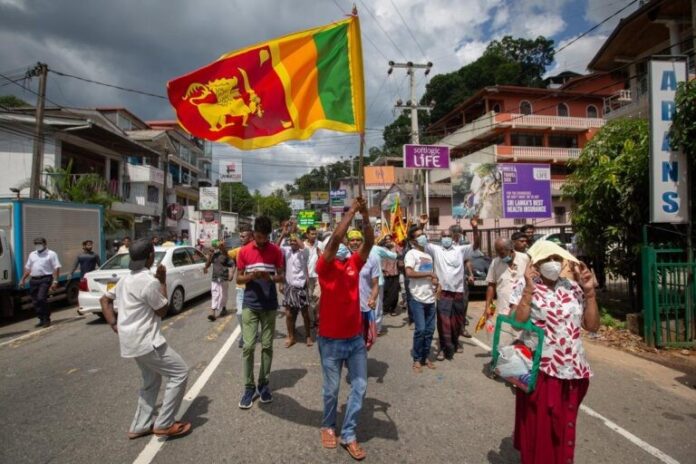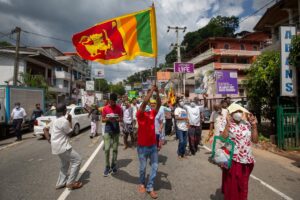by Gaurav Kumar 27 May 2022
Sri Lanka is facing a quagmire of multiverse political and economic issues. The inflation rate in the country increased to 25%. The cost of essential items is skyrocketing. Economic experts are considering the biggest economic crisis since the independence of 1948. If you roam around Colombo city for tea, you will have to pay up to 100 Sri Lankan rupees. Forex currency reserves have been reduced to 2.34 billion dollars, limiting them to nearly 70% of what they were in December 2020, i.e. for one month’s worth of goods imports.is under a huge crush on basic amenities. Sri Lanka has draped repayment of approximately $7 billion in foreign debts due this year out of a total of US $25 billion to be repaid by 2026. The country’s total foreign debt is USD 51 billion.
Sri Lanka has never seen such distraught before. It ranked as a good performance in the Human Development Index in South Asia. In 2020, Sri Lanka ranked 72 and India was around 131 in the HDI index. Sri Lanka has a literacy rate of 92 percent. medical, tourism and education infrastructures have excelled over their Indian counterparts in the early 2000s. Tourism and natural resources are the major assets of the Sri Lankan economy. Tourism contributed 10–12 percent of GDP until 2019, but the Easter Bombing in April 2019 and the subsequent Covid Blackout have severely harmed the tourism industry. Foreigners have decreased from 10–12 million to 10–12 thousand. Foreigners are now hesitant to visit Sri Lanka.
Sri Lanka was the first country to open its economy to liberalisation in the 1970s. It had welcomed foreign goods and FDI, but its local products were not mature enough to compete with global goods. Sri Lanka quickly liberalised its main agricultural sectors, which could not compete with imports from industrialised nations. Farmers didn’t get a good amount due to imported rice. No domestic industries developed.
Though according to a small case study, other neighbouring countries, such as India and China, opened their economies to liberalism, they preferred short and steady growth, unlike Sri Lanka, which adapted to the IMF’s shock-therapy. Further Structural Adjustment Programmes of the IMF have been granted to Sri Lanka, whose debt rose from 22.5 million US dollars in 1965 to 1326 million US dollars. 1.5 billion had been given as an Extended Fund Facility by the IMF as a debt. This all has slowly contributed to today’s Sri Lankan economic situation.
It is with great suffering that Sri Lanka’s political history provides insights into the tenacity of a political dynasty that is arguably South Asia’s biggest, perhaps its most brazenly nepotistic, and one that cannot be written off even now.
Majoritarian Politics in Sri Lanka: Leaders of Sri Lanka’s Sinhala community sought to secure dominance over the government through their majority. Since 1980, the north and east of Sri Lanka have seen a convergence of violence between the Sri Lanka Army and LTTE militants. The LTTE war worsened society’s social and economic structures. Trade unions were banned. In the latest events following the aftermath of the Easter bombings in April 2019, several anti-Muslim riots were broken by bigoted supremacist Buddhist groups with the hidden support of the Rajapaksha government.
In 2019, Gotabaya Rajapaksa won the 2019 election by promising a reduction in Value Added Tax (VAT) from 15% to 8%. Farmers were notified to ban synthetic fertilisers and were encouraged to use organic farming only. The import of fertilisers was a disaster. Scientifically, it takes 3 years to initiate at least.
The present arrangement is that PM Ranil tries to cool down the streets over the coming days and weeks. Swiftly Prime Minister Ranil Wickremesinghe said in April that the street protests were Sri Lanka’s Arab Spring moment, “but we have to avoid an Arab-Spring ending.”
“What is most disturbing is that the harsh economic conditions have led to violence on the streets,” says Santha Devraj, Professor of Georgetown Economics. The context and socio-political vibes are not the same as in the 1980s. However, the current circumstances could lead to a security concern where the government is set to increase its militaristic footprint and which will further undermine the democratic space amid an economic crisis.
India’s Role
As part of its international and South Asian policies, India follows the so-called “Neighbor First” principle. Sri Lanka has been granted USD 3.5 million lines of credit in the first quarter of 2022. We have transported essential medical and food supplies on humanitarian grounds. While the majority of civil society in Sri Lanka welcomed India’s assistance, a small group is skeptical of the country’s reliance on India. Now, the new Prime Minister, Wickremsighnese, seems liberal towards India. Many Indian projects in Sri Lanka that saw the light of the day in the initial months of this year had been agreed upon for 2017-18. The coming days are an opportunity for India to refine its perception among the people of Sri Lanka by way of its actions in assisting Sri Lanka to recover from this conundrum.


